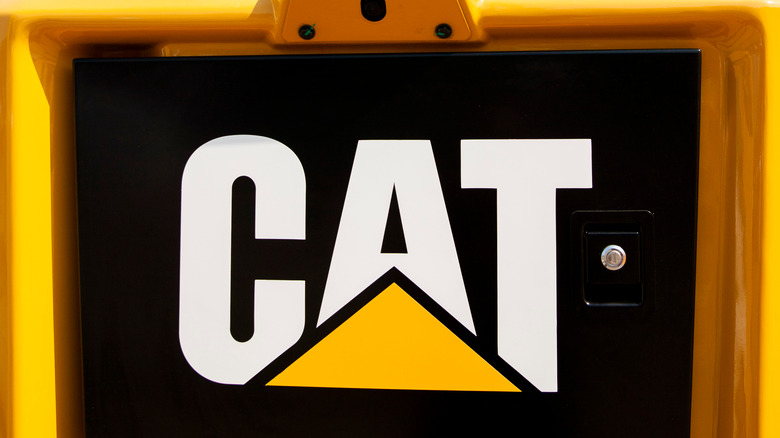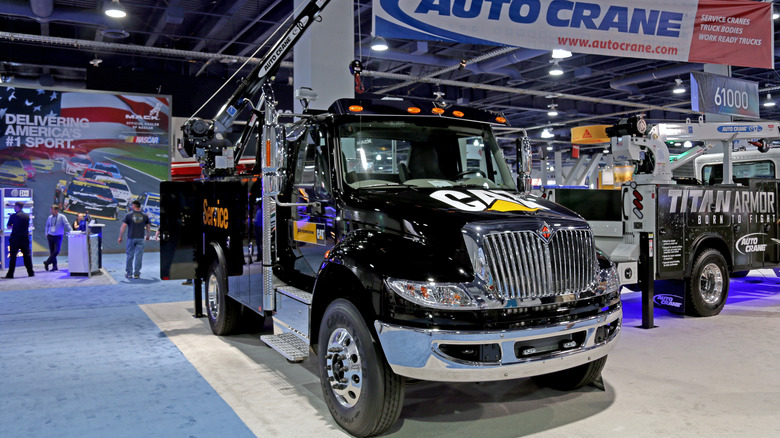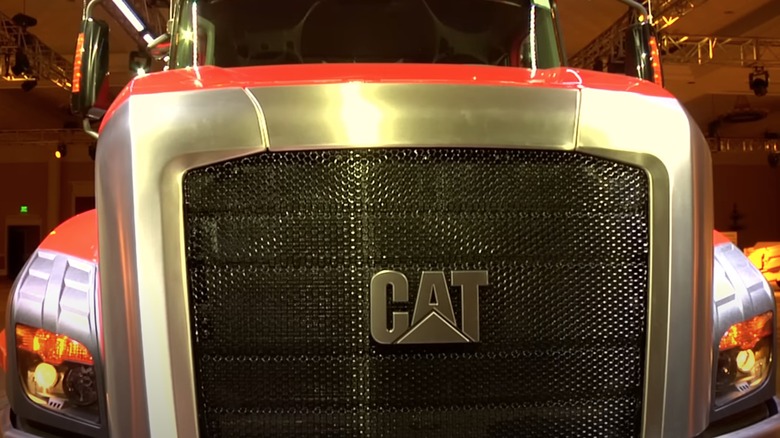Caterpillar's History With Truck Engines Goes Back Farther Than You May Have Realized
The Caterpillar brand has long been associated with vehicles in the heavy-machining world, with its unmistakable logo emblazoned on the side of vehicles regularly seen moving dirt, rocks, and everything in between on industrial work sites. The company has also lent its iconic name and logo to everything from a popular line of hand tools to durable worksite wear, but much earlier in the company's history, CAT was diversifying into diesel engines, and rumors are swirling that it is developing its own CAT branded pickup truck.
While the company's legacy was built on the backs of its innovative tractors, and earth-movers, manufacturing the enormous engines used to power those machines has proven just as lucrative for the company. This included diesel engines designed to run smaller vehicles, like those powering the 18-wheelers we regularly see barreling down the freeway. You may not realize it, but the company's ties to the trucking industry stretch back nearly a full century, with CAT having outfitted all manner of transport trucks with their powerful diesel engines since the 1930s.
For much of its existence, engines used in the trucking industry provided a solid alternate revenue stream for CAT. So much so, the heavy machinery company claims to have more than 1 million on-highway in-house engines still in use throughout the world. Here's a brief look at CAT's long-standing ties to truck engines and the trucking world at large.
CAT has been making truck engines since the 1930s
If you've been tracking CAT's ties to the trucking industry over the years, you know the company has focused mainly on engines that power its off-highway heavy machines for over a decade, as it stopped making on-highway truck engines in 2010. That brought to an end a celebrated legacy that began in 1939, when the company's six-cylinder, 90 horsepower D468 became its first engine designed specifically for use in a truck. CAT's second truck engine, the D312, began powering trucks in 1940, but both engines were discontinued when the advent of WWII changed the company's focus.
The company didn't get back into the truck engine market until the 1960s, developing several powerful engines like the dual overhead cam 1693, which some truckers claimed could top 425 horsepower. Later that decade, CAT struck a deal to provide Ford with its 1100 series engines, which quickly established it as a major player in the trucking game. CAT continued to innovate on the truck engine front throughout ensuing decades, delivering the beloved 3300 and 3400 builds to truckers in the '70s, and the more fuel-efficient 3406 and 3408 engines in the '80s, the former of which was a best-seller until it was discontinued in the late-'90s.
However, the company hit new heights in the early 2000s, when its C16, C7, C13, and 625hp C15 (affectionately dubbed "King of the Hill") became some of the more revered trucking engines in the industry. Though the company stopped making on-highway engines at decade's end, C-series engines are indeed still powering trucks on the road.
Claims that CAT is developing a pickup truck appear to be completely false
With Caterpillar having so much history in the truck engine market, fans of the brand have often wondered why the company has never developed a smaller diesel line for pickup trucks. Despite a Caterpillar engine currently powering the world's biggest SUV, it seems the company's desire to stay out of the crowded on-highway engine market hasn't changed. That desire was made more apparent in 2016, when CAT opted not to proceed with plans to manufacture a line of its own vocational on-highway vehicles.
Nonetheless, CAT's lack of options for smaller vehicles like pickup trucks hasn't stopped fans from thirsting after such a product. The latest rumor surrounding CAT and a small diesel option is that the company is not only developing the engine, but an entire pickup truck to put it in. There's even been a rash of YouTube videos claiming to have shots of a prototype for the company's first pickup truck. However, CAT has never confirmed or even teased that they were looking to get into the small diesel engine market, let alone manufacture an actual vehicle of their own.
It's more likely than not that the pictures being touted are AI-generated. Combined with the lack of an official announcement from the company, it seems that the rumors of a CAT truck hitting the road in 2025 are completely false. However, the idea of a pickup truck powered by a CAT engine remains intriguing, to say the least.


